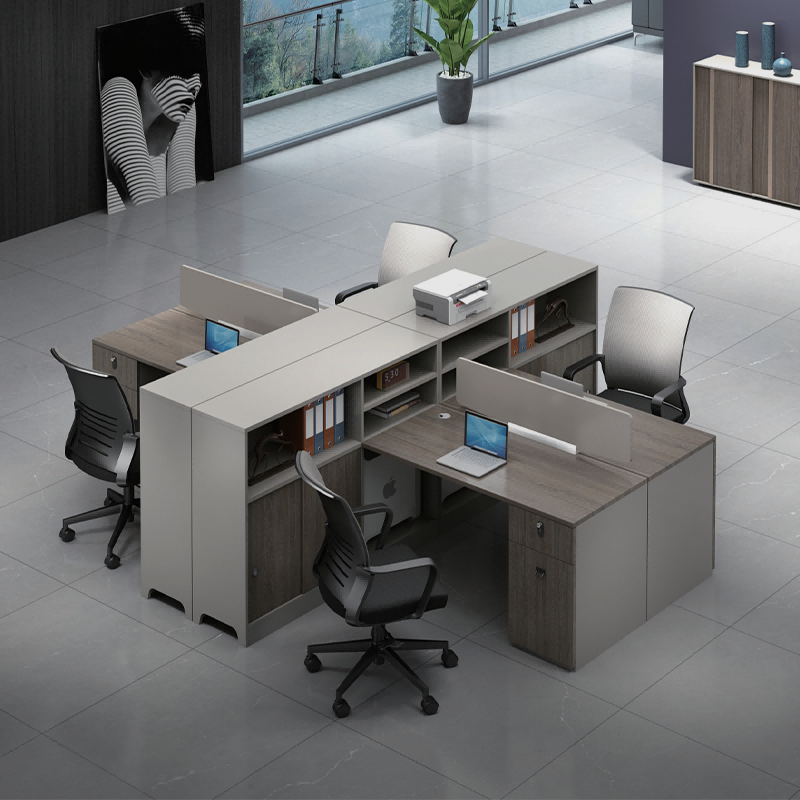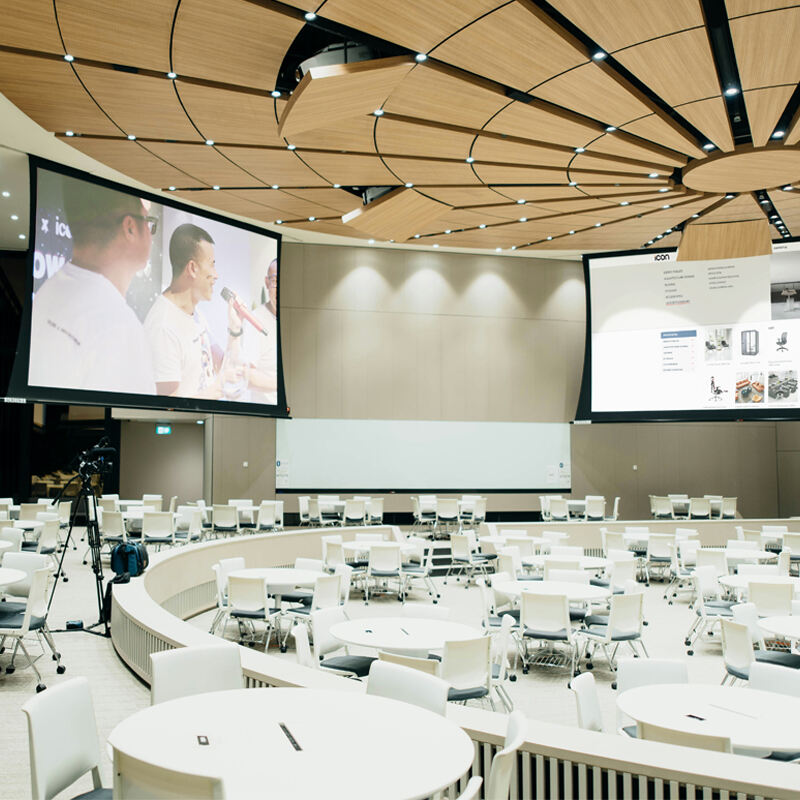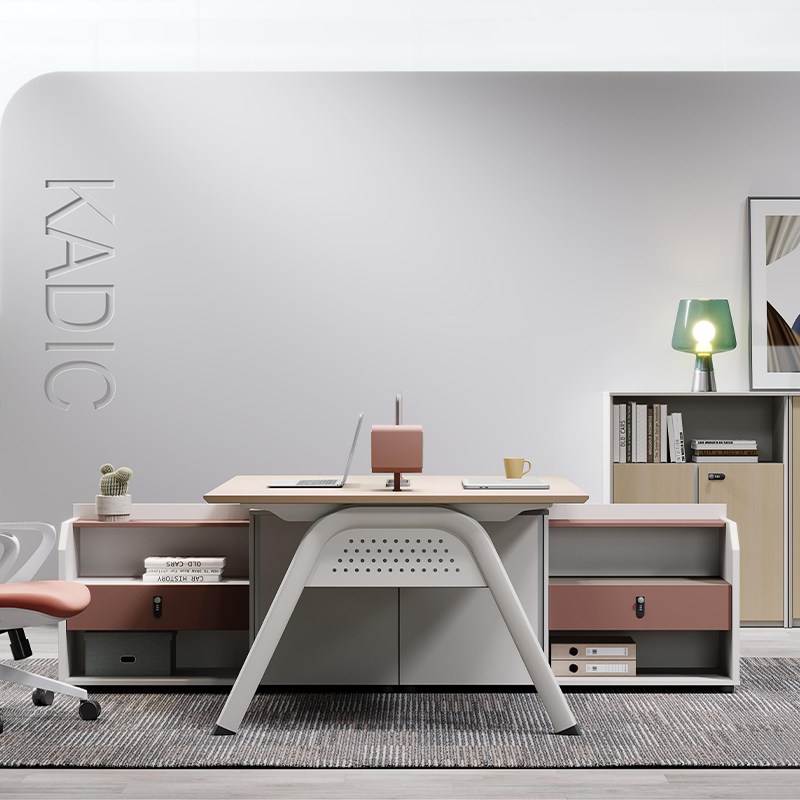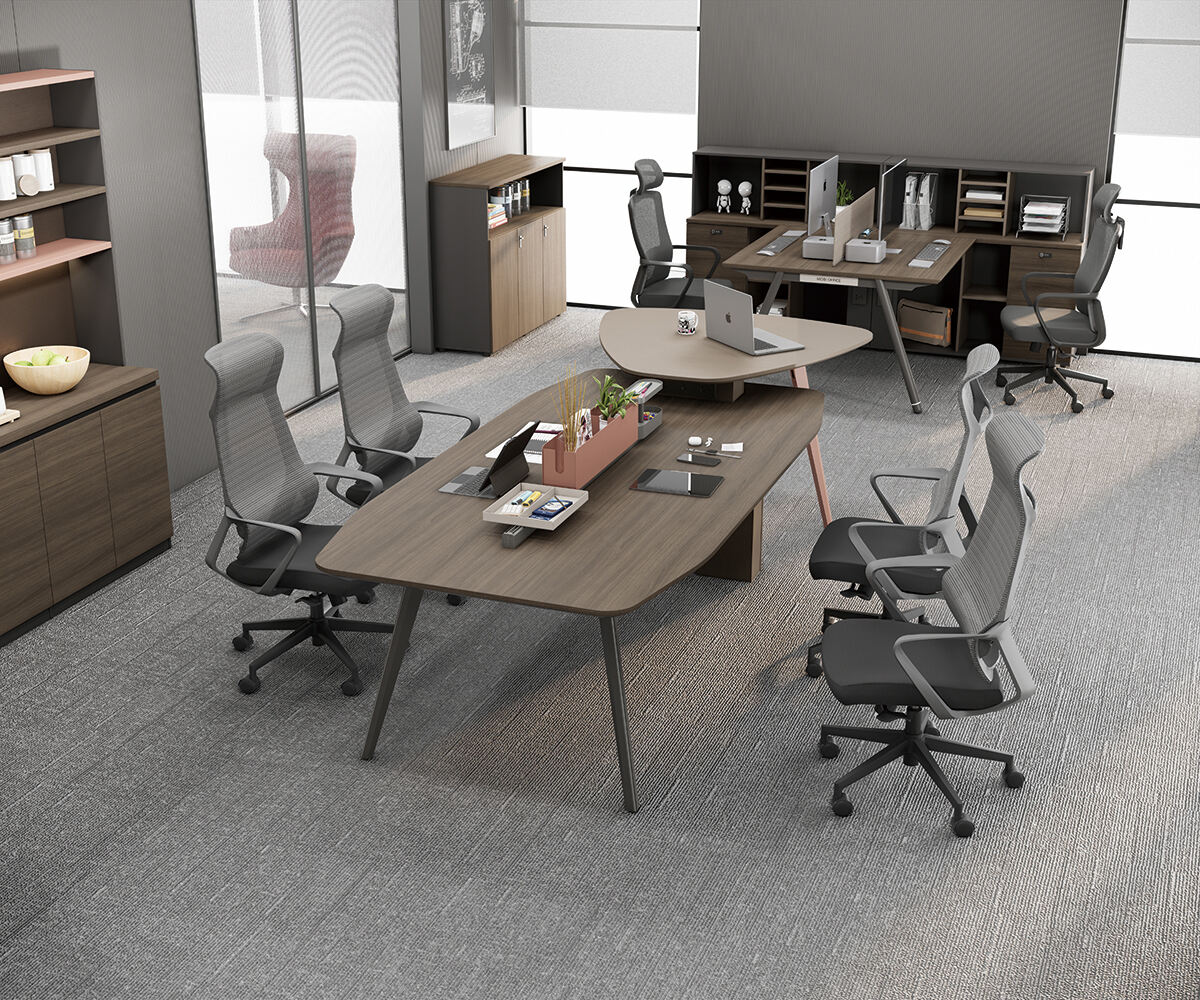Spațiul tău de lucru ar trebui să inspire productivitate și creativitate, oferind în același timp confort. Mobilier de birou joacă un rol esențial în atingerea acestui echilibru. Când funcționalitatea se întâlnește cu estetica, biroul tău devine mai mult decât un loc de muncă—se transformă într-un mediu care susține bunăstarea ta. Mobilierul gândit cu atenție poate spori concentrarea, reduce efortul fizic și chiar poate genera idei inovatoare. O amenajare vizual atrăgătoare nu doar că arată bine; te face să te simți bine, de asemenea. Prin alegerea pieselor potrivite, creezi un spațiu în care eficiența și stilul coexistă fără probleme.
Evoluția mobilierului de birou
De la designuri tradiționale la cele moderne
Mobilierul de birou a parcurs un drum lung de la primele sale zile. Designurile tradiționale s-au concentrat pe durabilitate și practică. Birourile și scaunele grele din lemn dominau locurile de muncă, oferind funcționalitate, dar puțin în ceea ce privește stilul sau confortul. Aceste piese își îndeplineau scopul, dar lipseau de flexibilitate și atractivitate vizuală pe care ai putea să te aștepți astăzi.
Designurile moderne au schimbat regulile jocului. Liniile elegante, materialele ușoare și formele inovatoare definesc acum mobilierul de birou contemporan. Designerii prioritizează atât forma, cât și funcția, creând piese care arată grozav și funcționează și mai bine. Vei observa cum mobilierul modern se adaptează la spații mai mici, susține colaborarea și reflectă tendințele actuale. Această schimbare a făcut birourile mai dinamice și primitoare, ajutându-te să te simți mai conectat la spațiul tău de lucru.
Rolul tehnologiei în modelarea mobilierului de birou
Tehnologia a revoluționat modul în care mobilierul de birou este proiectat și utilizat. Birourile ajustabile, scaunele ergonomice și sistemele de gestionare a cablurilor sunt doar câteva exemple de cum tehnologia a influențat mobilierul. Probabil ai văzut birouri în picioare care îți permit să schimbi între a sta jos și a sta în picioare cu apăsarea unui buton. Aceste inovații au ca scop îmbunătățirea confortului și productivității tale.
Mobilierul inteligent câștigă, de asemenea, popularitate. Unele birouri vin acum cu porturi de încărcare integrate sau chiar cu pad-uri de încărcare wireless. Scaunele cu senzori pot monitoriza postura ta și te pot reaminti să stai corect. Aceste progrese fac mai ușor să rămâi confortabil și concentrat pe parcursul zilei. Tehnologia nu doar că îmbunătățește funcționalitatea; adaugă, de asemenea, o estetică modernă și high-tech spațiului tău de lucru.
Adaptarea la nevoile și tendințele în schimbare ale locului de muncă
Locurile de muncă evoluează constant, iar mobilierul de birou evoluează odată cu ele. Birourile cu plan deschis au înlocuit cubiclele în multe companii, necesitând mobilier care să susțină colaborarea și flexibilitatea. S-ar putea să observi cum mobilierul modular îți permite să-ți reconfigurezi spațiul cu ușurință, adaptându-se la diferite sarcini sau dimensiuni ale echipei.
Munca la distanță a influențat de asemenea designul mobilierului. Birourile compacte și scaunele ergonomice sunt acum esențiale pentru Pagina principală birouri. Designerii se concentrează pe crearea de piese care se potrivesc în spații mai mici fără a sacrifica confortul sau stilul. Această adaptabilitate asigură că mobilierul tău îți îndeplinește nevoile, fie că lucrezi într-un birou corporativ sau de acasă.
Evoluția mobilierului de birou reflectă modurile în care lucrăm. Prin combinarea meșteșugului tradițional cu inovația modernă, designurile de astăzi îți oferă echilibrul perfect între funcționalitate și estetică.
Principii cheie de design pentru combinarea funcționalității și esteticii
Minimalismul în mobilierul de birou modern
Minimalismul a devenit o piatră de temelie a designului modern de mobilier de birou. Concentrându-te pe simplitate, poți crea un spațiu de lucru care se simte deschis și neîncărcat. Liniile curate, culorile neutre și designurile funcționale definesc mobilierul minimalist. Aceste elemente nu doar că îmbunătățesc atractivitatea vizuală a biroului tău, dar te ajută și să rămâi concentrat prin reducerea distragerilor.
Atunci când alegi mobilier minimalist, caută piese care servesc mai multor scopuri. Un birou elegant cu spațiu de depozitare integrat sau un scaun care combină confortul cu stilul pot face ca spațiul tău de lucru să fie atât practic, cât și elegant. Minimalismul nu înseamnă sacrificarea funcționalității. În schimb, te încurajează să prioritizezi ceea ce contează cu adevărat în configurarea biroului tău.
Ergonomie: Susținerea confortului și sănătății
Ergonomia joacă un rol vital în designul mobilierului de birou. Mobilierul potrivit poate susține postura ta, reduce efortul fizic și îmbunătăți bunăstarea generală. O scaun ergonomic, de exemplu, oferă suport lombar adecvat și caracteristici ajustabile pentru a se potrivi corpului tău. Un birou cu înălțime ajustabilă îți permite să alternezi între statul pe scaun și în picioare, promovând o circulație mai bună și reducând oboseala.
Petreci ore întregi la birou, așa că investiția în mobilier ergonomic este esențială. Nu este vorba doar despre confort; este vorba despre sănătatea ta. Mobilierul prost conceput poate duce la dureri de spate, tensiune la nivelul gâtului și alte probleme. Designurile ergonomice asigură că spațiul tău de lucru te susține fizic, permițându-ți să lucrezi eficient fără disconfort.
Impactul culorii, texturii și materialelor asupra designului
Culorile, texturile și materialele mobilierului de birou pot influența semnificativ atmosfera spațiului tău de lucru. Culorile strălucitoare, cum ar fi galbenul sau portocaliul, pot stimula energia și creativitatea, în timp ce nuanțele mai blânde, cum ar fi albastrul sau verdele, promovează calmul și concentrarea. Alegerea paletei de culori potrivite te ajută să stabilești atmosfera pentru biroul tău.
Texturile și materialele joacă, de asemenea, un rol esențial. Suprafațele netede, cum ar fi sticla sau lemnul lustruit, oferă o senzație modernă și profesională. Materialele naturale, cum ar fi bambusul sau lemnul recuperat, adaugă căldură și sustenabilitate spațiului tău. Amestecarea texturilor, cum ar fi asocierea unei scaune din piele cu un birou din lemn, poate crea un design vizual interesant și echilibrat.
Acordând atenție acestor detalii, poți asigura că mobilierul tău de birou nu doar că arată bine, dar îți îmbunătățește și productivitatea și starea de spirit. Combinația potrivită de culoare, textură și material poate transforma spațiul tău de lucru într-un mediu în care te simți inspirat și confortabil.
Versatilitate și Funcționalitate în Mobilierul de Birou
Mobilier Multifuncțional pentru Optimizarea Spațiului
Când spațiul este limitat, fiecare piesă de mobilier ar trebui să îndeplinească mai mult de un scop. Mobilierul multifuncțional te ajută să profiți la maximum de spațiul tău de lucru fără a te simți înghesuit. De exemplu, un birou cu rafturi sau sertare încorporate poate oferi atât o suprafață de lucru, cât și spațiu de depozitare. O bancă cu compartimente ascunse poate servi atât ca loc de șezut, cât și ca loc de depozitare a materialelor. Aceste designuri economisesc spațiu, menținându-ți biroul organizat.
De asemenea, ai putea lua în considerare mobilierul pliabil sau extensibil. O masă care se pliază atunci când nu este folosită sau un scaun care poate fi stivuit oferă flexibilitate. Aceste opțiuni sunt perfecte pentru birouri mai mici sau spații comune. Alegând mobilier multifuncțional, creezi un mediu funcțional care se adaptează nevoilor tale.
Designuri Modulare pentru Flexibilitate și Adaptabilitate
Mobilierul modular îți oferă libertatea de a-ți personaliza spațiul de lucru. Aceste piese sunt concepute pentru a se potrivi împreună în moduri diferite, permițându-ți să le reorganizezi după cum este necesar. De exemplu, birourile modulare pot fi grupate pentru proiecte de echipă sau separate pentru sarcini individuale. Această flexibilitate face mai ușor să ajustezi aranjamentul biroului pe măsură ce nevoile tale se schimbă.
Un alt avantaj al designurilor modulare este scalabilitatea lor. Dacă echipa ta crește, poți adăuga mai multe piese fără a înlocui mobilierul existent. Scaunele modulare, cum ar fi canapele secționale sau scaunele, pot fi de asemenea reconfigurate pentru a se potrivi diferitelor scopuri. Această adaptabilitate asigură că mobilierul tău de birou evoluează odată cu tine, oferind atât funcționalitate, cât și stil.
Soluții de depozitare elegante care maximizează utilitatea
Depozitarea nu trebuie să fie plictisitoare. Soluțiile de depozitare elegante combină practicitatea cu designul, ajutându-te să îți menții biroul ordonat în timp ce îmbunătățesc estetică acestuia. Ia în considerare unitățile de rafturi deschise care afișează cărți sau obiecte decorative, adăugând personalitate spațiului tău de lucru. Dulapurile cu finisaje elegante sau mânere unice pot servi ca piese de declarație.
Depozitarea ascunsă este o altă opțiune excelentă. Birourile cu compartimente ascunse sau otomanele cu capace ridicabile mențin dezordinea departe de vedere. Aceste designuri păstrează un aspect curat și profesional în timp ce oferă mult spațiu de depozitare. Alegând soluții de depozitare elegante, poți menține biroul organizat fără a sacrifica atractivitatea sa vizuală.
Designul sustenabil în mobilierul de birou
Materiale și practici ecologice în mobilierul modern
Sustenabilitatea a devenit un punct focal cheie în designul mobilierului de birou modern. Vei observa că mulți producători prioritizează acum materiale ecologice pentru a reduce impactul asupra mediului. Lemnul recuperat, bambusul și metalele reciclate sunt alegeri populare. Aceste materiale nu doar că minimizează deșeurile, dar aduc și o estetică unică în spațiul tău de lucru. De exemplu, birourile din lemn recuperat au adesea imperfecțiuni naturale care adaugă caracter și căldură.
Practicile sustenabile depășesc materialele. Multe companii au adoptat procese de fabricație eficiente din punct de vedere energetic. Unele folosesc chiar adezivi pe bază de apă și finisaje netoxice pentru a se asigura că acestea Produse sunt sigure pentru tine și pentru mediu. Alegând mobilier fabricat cu aceste practici, susții o planetă mai verde în timp ce creezi un spațiu de lucru mai sănătos.
Cum Sustenabilitatea Îmbunătățește Atât Funcționalitatea, Cât și Estetica
Designul sustenabil nu beneficiază doar mediul—îmbunătățește de asemenea funcționalitatea și estetica mobilierului de birou. Materialele ecologice, cum ar fi bambusul, sunt ușoare, dar durabile, făcându-le perfecte pentru designuri versatile. Metalele reciclate oferă rezistență fără a adăuga volum, permițând stiluri de mobilier elegante și moderne.
Din punct de vedere vizual, mobilierul sustenabil iese adesea în evidență. Texturile naturale și tonurile pământii creează o atmosferă liniștitoare, ajutându-te să te simți mai conectat la spațiul tău. Aceste designuri se integrează perfect în diverse teme de birou, de la minimalist la industrial. Funcționalitatea primește de asemenea un impuls. Multe piese sustenabile sunt modulare sau multifuncționale, oferind flexibilitate în timp ce își mențin atractivitatea ecologică.
Când investești în mobilier sustenabil, nu faci doar o alegere etică. De asemenea, îți îmbunătățești spațiul de lucru cu piese care arată bine și funcționează excelent.
Exemple de mobilier de birou sustenabil inovator
Piața oferă o mulțime de opțiuni inovatoare de mobilier de birou sustenabil. Un exemplu remarcabil sunt birourile fabricate din materiale reciclate. Aceste birouri combină lemnul recuperat cu cadre din oțel reciclat, oferind atât durabilitate, cât și stil. Un alt exemplu sunt scaunele realizate din plastice reciclate din oceane. Aceste scaune nu doar că reduc deșeurile, dar au și un design ergonomic pentru un confort maxim.
De asemenea, ai putea explora sisteme de mobilier modulare fabricate din materiale ecologice. Aceste sisteme îți permit să îți personalizezi spațiul de lucru, menținând în același timp o amprentă de carbon scăzută. Unele companii oferă chiar mobilier cu jardiniere integrate, îmbinând funcționalitatea cu designul biophilic. Aceste piese aduc verdeață în biroul tău, îmbunătățind calitatea aerului și sporind starea de bine.
Alegând aceste opțiuni inovatoare, poți crea un spațiu de lucru care se aliniază valorilor tale. Mobilierul sustenabil dovedește că nu trebuie să faci compromisuri în privința stilului sau funcționalității pentru a face o alegere ecologică.
Sfaturi pentru găsirea echilibrului perfect între stil și funcționalitate
Identificarea nevoilor și obiectivelor spațiului de lucru
Înainte de a începe să alegi mobilierul, ia-ți un moment pentru a te gândi la ceea ce ai nevoie de la spațiul tău de lucru. Întreabă-te: Ce sarcini efectuezi zilnic? Ai nevoie de un birou mare pentru mai multe monitoare sau un birou compact ar fi suficient? Dacă colaborezi frecvent cu alții, s-ar putea să ai nevoie de aranjamente de șezut care să încurajeze munca în echipă. Pe de altă parte, dacă munca ta necesită concentrare, un setup privat și organizat ar putea fi mai potrivit.
Ia în considerare cât de mult spațiu de depozitare ai nevoie. Te ocupi cu fișiere fizice sau majoritatea muncii tale este digitale? Dacă dezordinea tinde să se acumuleze, prioritizează mobilierul cu opțiuni de depozitare integrate. De asemenea, gândește-te la spațiul pe care îl ai. Măsoară zona biroului tău pentru a te asigura că mobilierul se potrivește confortabil fără a face camera să pară înghesuită. Prin identificarea nevoilor și obiectivelor tale, vei crea un spațiu de lucru care să susțină productivitatea și confortul tău.
Selectarea mobilierului care reflectă identitatea brandului tău
Mobilierul tău de birou ar trebui să facă mai mult decât să îndeplinească o funcție—ar trebui să spună și o poveste despre cine ești. Fie că proiectezi un birou acasă sau un spațiu de lucru corporativ, mobilierul pe care îl alegi poate reflecta personalitatea brandului tău. De exemplu, designurile elegante și moderne ar putea transmite inovație și gândire avansată, în timp ce piesele rustice sau vintage ar putea sugera căldură și tradiție.
Gândește-te la culorile, materialele și stilul general care se aliniază cu brandul tău. Dacă brandul tău valorizează sustenabilitatea, optează pentru mobilier ecologic realizat din lemn recuperat sau materiale reciclate. Dacă creativitatea este în centrul muncii tale, culorile îndrăznețe și designurile unice pot face o declarație. Chiar și detalii mici, cum ar fi forma unui scaun sau finisajul unei birouri, pot contribui la impresia generală pe care o oferă spațiul tău de lucru. Prin alinierea alegerilor tale de mobilier cu identitatea brandului tău, creezi un mediu coerent și memorabil.
Echilibrarea bugetului, calității și preferințelor de design
Găsirea mobilierului de birou perfect înseamnă adesea jonglarea între buget, așteptările de calitate și preferințele de design. Începe prin a stabili un buget clar. Știind cât ești dispus să cheltuiești te ajută să restrângi opțiunile și să eviți cheltuielile excesive. Cu toate acestea, nu lăsa prețul să fie singurul factor. Mobilierul ieftin ar putea să-ți economisească bani la început, dar ar putea costa mai mult pe termen lung dacă se degradează rapid.
Concentrează-te pe calitate. Caută materiale durabile și o construcție solidă. O scaun sau un birou bine făcut va dura mai mult și va oferi un suport mai bun, făcându-l o investiție valoroasă. În același timp, nu face compromisuri în privința designului. Mobilierul tău ar trebui să se potrivească stilului tău și să facă spațiul de lucru primitor. Dacă lucrezi cu un buget restrâns, ia în considerare prioritizarea pieselor cheie, cum ar fi un scaun ergonomic sau un birou funcțional, apoi adaugă treptat articole decorative sau secundare pe măsură ce bugetul îți permite.
Pentru a găsi echilibrul potrivit, compară opțiunile și citește recenzii. Mulți producători oferă mobilier elegant și funcțional la prețuri rezonabile. Fiind atent la alegerile tale, poți crea un spațiu de lucru care arată grozav, se simte confortabil și se încadrează în bugetul tău.
Îmbinarea funcționalității și esteticii în mobilierul de birou transformă spațiul tău de lucru într-un centru de productivitate și confort. Alegerile de mobilier bine gândite nu doar că îmbunătățesc eficiența, dar cresc și satisfacția angajaților prin crearea unui mediu inspirator. Atunci când alegi piesele, concentrează-te pe ceea ce susține sarcinile tale zilnice, reflectând în același timp stilul tău personal sau al brandului. Prioritizează designurile ergonomice pentru confort și alege opțiuni versatile care se adaptează nevoilor tale. Prin echilibrarea stilului cu practicitatea, poți proiecta un spațiu de lucru care te motivează și te împuternicește în fiecare zi.





